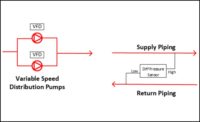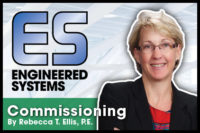Having the ability to modulate various components of our HVAC systems (pumps, fans, valves, dampers, boilers, chillers, etc.) is a good thing. Advancements in various technologies over the years have allowed for increased levels of modulation in these components. Modulation allows for more stable control, energy savings, and extended equipment life expectancies. When troubleshooting or fine-tuning the automation of HVAC systems, I now carry a general suspicion there will be room for better modulation that will solve our known issues or improve the operation of the systems in some other way. I carry these suspicions because I’ve seen so many different oversights that hinder the ability to modulate HVAC systems. This article outlines a few such examples, where hindered modulation of a single HVAC component generated issues for the larger system as a whole.
Limited range of the controlled device
A controlled device is a controlled component in an HVAC system. Supply or return fans at air-handling units (AHUs) are examples. I often find the minimum speed setting the fans are allowed to operate at configured inappropriately on the variable frequency drive (VFD). I had a supply fan’s minimum speed found at 35 hz (ASHRAE now recommends as low as 6 hz1) when we started investigating noise coming from a VAV box during a mild day. Nearly all served VAVs were at minimum airflow, and the supply fan could not slow down enough due to this inappropriately high minimum speed setting, resulting in static pressure in the supply duct being two-and-a-half times the set point. This resulted in VAV dampers throttling down excessively and forcing the air through a much narrower opening, which generated the noise we were investigating. It also meant controllability at the VAV boxes was poor, fan energy was being wasted, and the fan was operating within the surge region of its fan curve.
Uncoordinated minimums
Oftentimes, an appropriate minimum speed setting is configured on a fan’s VFD. However, the BAS programmer also puts a minimum value on their output signal and then the scaling parameters on the VFD are configured in a way that compounds the minimums, unnecessarily reducing the range of speeds the fan can operate at. Let me explain. Say the minimum speed on the VFD was set to 12 hz. The VFD is then configured to scale the BAS signal from minimum speed (12 hz) at a 0% signal to maximum speed (e.g., 60 hz) at a 100% signal. Then, the BAS programmer limits their output signal range from 20%-100%. Now the smallest signal sent from the BAS will be 20%, which will be interpreted by the VFD as 20% between its configured minimum speed (12 hz) and maximum speed (60 hz), and the resulted fan operating speed will be 24 hz. The VFD’s minimum speed and BAS’s minimum speed are compounded, further limiting the speed range the fan can operate at.
Inappropriate set point range used in reset programs
Static pressure set point reset for AHU supply fans is becoming more common. The active static pressure set point is reset to keep at least one served VAV box near full open. This will ensure the supply fan operates at the lowest pressure possible while still meeting flow requirements of served VAV boxes. The static pressure set point has a range it can reset within. The maximum value is the value needed to satisfy all served boxes during a design cooling day, when all boxes are calling for maximum cooling airflow. The minimum value should be some value less than that. I will often review trends of the active static pressure set point and find it is pinned at minimum for months out of the year. This means we can lower the minimum set point even further. On one hospital I work at, the maximum value of the static pressure set point was at 2 inches of water column (w.g.), and the minimum was at 1.5 inches w.g. The active static pressure set point was always pinned at its minimum value. We temporarily lowered the minimum to .05 inches w.g. just to see where the active static pressure set point settled out at, and that value was 0.4 inches w.g. — substantially less than the 1.5 inches w.g. minimum being used previously.
Inappropriate control response
Control response is how a controller responds to error from set point. The three common types are two-position (on-off) control, floating control, and modulating control. If modulating control is to be implemented, you need to have a controlled device capable of receiving a modulating signal from the controller. If you have a device capable of modulating, but the serving controller utilizes two-position control, why did you pay the premium for the modulating device? Here are two recent examples.
About two years ago, in a building I had become familiar with, the actuator on a makeup water valve serving a condenser water system failed. Until that point, I had not paid much attention to that valve, since every time I had looked on the BAS, the water level at the cooling tower’s remote sump was operating pretty close to set point. After the valve actuator replacement, I looked deeper to realize the BAS output to the valve was not displayed on the BAS. I asked the controls service provider for the building to add that to the graphic. A few months later, I was at the building again, reviewed the updated BAS graphic, and realized the valve was cycling between a 0% and 100% signal. Review of the control system as-built shop drawings indicated a modulating valve, not a two-position valve. I confirmed the newly installed valve was a modulating valve as well, and the output to the valve was coming from an analog output (AO) terminal on the controller. The controls service provider investigated and found they were inappropriately operating in a two-position manner. Even worse, there was no control differential. If the water level was evenly slightly above set point, the valve was commanded closed. If the water level was slightly below set point, the valve was commanded fully open. The controls service provider adjusted the programming to allow for proper modulating control. A few months later, the new valve actuator failed. Though I can’t prove it, I don’t believe this was a coincidence. I believe both failures were attributed to the valve actuator being subject to constant cycling between being commanded fully open and closed.
I once was on a retro commissioning project for a small historical society. Prior to my first site visit, the owner stated they don’t get adequate heat in the winter. Review of the as-built drawing set implied three condensing boilers with 5:1 turndown ratios, and N+1 redundancy (i.e., they should be able to heat the building with only two of the three boilers on a design day). For the first day on-site, I requested the controls service provider to accompany me and help me understand how the automation of the boiler plant was programmed. Upon arrival, we found two of the three boilers tripped out on high limit. Further review of the programming revealed a very unsophisticated boiler staging strategy. Once every 30 minutes, the BAS compared hot water supply temperature (HWST) to HWST set point. If HWST was above set point, it disabled a boiler. If HWST was below set point, it enabled another boiler. To make it worse, when a boiler was enabled, it operated at a fixed 50% capacity. All modulating capability of the boilers was handcuffed by a ridiculous control strategy programmed into the BAS. This resulted in poor temperature control as well as drastic overshooting of the HWST set point during milder conditions. This overshooting of set point resulted in pretty consistent high-limit trips (i.e., the safety aquastat on the discharge of the boiler triggered due to excessively high temperature, latching the boiler offline). It also resulted in inadequate heat in the winter, as only 75% of the needed heat was available (i.e., 50% capacity of three boilers is less than the needed 100% capacity of two boilers).
Oversized equipment
Even if the installed equipment has a modulating capability, if it’s drastically oversized for the application, it will operate in a two-position manner, cycling between minimum output and off. A humidifier on a makeup air unit in a building I work in failed a few years back. I had suspicions that the humidifier was drastically oversized, as we could not get it to control well prior to it failing. It constantly cycled on at minimum fire, overshot the supply air humidity set point, and then disabled. Replacing-in-kind was not the correct solution. We ran our own calculations on the required humidifier capacity and realized the installed one was three times larger than needed. Not only that, the installed one had a 3:1 turndown ratio, meaning its minimum output was still higher than the humidification demand in almost every hour of the humidification season. We right-sized the replacement humidifier, installing a much smaller one with a better turndown ratio, and it now controls very well to set point.
Inappropriately tuned control loops
If you have equipment capable of being modulated, then it needs to be modulated at an appropriate rate. The example that comes to mind is a cooling tower fan serving a condenser water system at a middle school. The control loop was so slow that, if the condenser water and chilled water systems enabled at 6 a.m. after a hot summer night, the fan speed would not ramp up quick enough, the condenser water supply temperature being sent to the water-cooled chiller would get excessively hot, and the chiller would trip out on surge protection within about 20 minutes.
Conclusion
Modulation in our HVAC systems is a good thing. If the installed equipment has good modulating capability, pay attention to the various oversights that can hold back the equipment from properly modulating. When a system is designed for good modulation, but it is being held back, this often results in numerous second order effects resulting in poor performance, energy waste, and premature equipment failure.
References:
1ASHRAE Guideline 36-2021, High-Performance Sequences of Operation for HVAC Systems.





